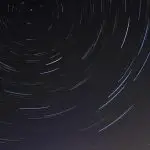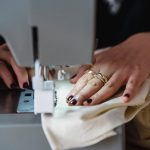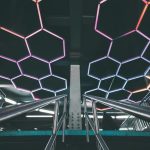When you're sewing with a bright light, the fabric you choose can make all the difference in your stitching experience. Understanding which fabric works best with sewing light is crucial for achieving mastery in your craft. By selecting the right fabric, you can optimize visibility, reduce eye strain, and ensure precise stitching.
In this guide, you'll explore the interaction between different fabrics and sewing light, learn about the best fabrics for bright sewing lights, and understand how fabric color and texture can impact your sewing experience.
Whether you're working in a dimly lit space or with a harsh sewing light, choosing the ideal fabric is key to achieving optimal results in your sewing projects.
Key Takeaways
- The color temperature of the sewing light affects the appearance of the fabric, with cool white lights enhancing blues and purples, while warm white lights enhance reds and oranges.
- Natural fabrics like cotton and silk have moderate reflectivity and work well with most lighting conditions.
- Lighter colors such as white, pastels, and neutrals enhance visibility under bright sewing lights, making them ideal for intricate work.
- Fabrics with a subtle sheen, like silk, enhance visibility of details under bright sewing lights, while matte fabrics minimize glare.
Understanding Sewing Light and Fabric Interaction
When choosing fabric for sewing with light, it's important to understand how the fabric's properties interact with the sewing light. The color temperature of the light source can significantly impact the appearance of the fabric. Cool white lights enhance blues and purples, while warm white lights enhance reds and oranges. Therefore, when selecting fabric, consider the color temperature of your sewing light and how it will affect the fabric's appearance.
Fabric selection is crucial when it comes to sewing with light. Natural fibers like cotton and silk tend to work well with most lighting conditions, while synthetic fabrics such as polyester may appear differently under certain lights. Additionally, the impact of fabric weave shouldn't be underestimated. The weave can affect how the fabric reflects or absorbs light, ultimately influencing the appearance of the garment.
Understanding lighting compatibility is essential for achieving the desired results. Some fabrics may appear distorted or uneven under certain lighting conditions, affecting the overall look of the finished piece. By being mindful of color temperature, fabric selection, impact of fabric weave, and lighting compatibility, you can ensure that your sewing projects look their best under any lighting conditions.
Best Fabrics for Bright Sewing Lights
You should consider using natural fabrics like cotton and silk for bright sewing lights as they tend to work well with most lighting conditions. These fabrics have a moderate fabric reflectivity, allowing them to appear evenly lit under bright sewing lights.
When choosing fabrics for bright sewing lights, keep in mind the following:
- Fabric Reflectivity: Natural fabrics like cotton and silk have a moderate reflectivity, which helps in diffusing the sewing light evenly across the fabric, reducing glare and harsh shadows.
- Color: Opt for lighter colors such as white, pastels, and neutrals when working with bright sewing lights. Lighter colors reflect more light, enhancing visibility and reducing eye strain.
- Sewing Light: Bright sewing lights are ideal for intricate work, and natural fabrics like cotton and silk complement these lights by providing a balanced sheen effect, making it easier to see fine details in your work.
- Sheen Effect: Fabrics with a subtle sheen, like silk, can enhance the visibility of intricate stitching and details under bright sewing lights, making it easier to achieve precision in your work.
Choosing Fabrics for Adjustable Sewing Lights
To achieve optimal results when using adjustable sewing lights, consider selecting fabrics with varying levels of reflectivity to ensure consistent illumination across different lighting conditions.
When choosing fabrics for adjustable settings, it's important to pay attention to the type of fabric and its color impact. Fabrics with a high sheen or reflective quality, such as satin or silk, can work well with adjustable sewing lights as they effectively bounce light, providing enhanced visibility of details.
On the other hand, matte fabrics like cotton or linen may require a higher level of illumination due to their lower reflectivity. Dark-colored fabrics absorb more light, so when working with adjustable sewing lights, it's advisable to use brighter settings for these materials. Conversely, light-colored fabrics reflect more light and may require lower intensity settings to avoid overexposure.
Understanding how different fabric types and colors interact with adjustable sewing lights will allow you to make informed decisions when selecting materials for your sewing projects, ensuring optimal visibility and precision.
How Fabric Color Impacts Sewing Light
Fabric color significantly impacts sewing light, affecting the amount of illumination required for different shades and tones. Understanding how fabric color psychology and the impact of fabric sheen can influence your sewing light will help you achieve optimal visibility and precision in your work.
Here are four key considerations for how fabric color impacts sewing light:
- Color Absorption: Dark-colored fabrics absorb more light, requiring higher illumination levels to work with precision. Lighter fabrics reflect more light, reducing the strain on your eyes and providing better visibility.
- Contrast: When working with fabrics of similar colors to your sewing space, the lack of contrast can make it challenging to see details. Choosing contrasting colors between your fabric and the surrounding area can help improve visibility.
- Sheen Effect: Fabrics with a glossy or shiny finish can create glare under certain lighting conditions, affecting visibility and making it harder to see details. Matte fabrics, on the other hand, minimize glare and provide a more even distribution of light.
- Color Temperature: The color temperature of your sewing light can interact differently with fabric colors, affecting how the colors appear and influencing your perception of the fabric's true shade.
Fabric Texture and Its Effect on Sewing Light
When choosing fabrics for your sewing projects, consider how the texture will impact your lighting.
Smooth fabrics like satin and silk will reflect light, helping to brighten your workspace.
However, textured fabrics such as corduroy or tweed may absorb light, making it more challenging to see your stitches clearly.
Also, keep in mind that heavier fabrics can create shadows, affecting the overall illumination.
Smooth Fabrics Reflect Light
You should always choose smooth fabrics because they reflect light most effectively, enhancing visibility while sewing. When it comes to fabric texture and its effect on sewing light, smooth fabrics are the top choice. Here's why:
- Light reflection: Smooth fabrics such as satin and silk reflect light better than textured fabrics, providing optimal illumination for your sewing projects.
- Enhanced visibility: The smooth surface of fabrics like cotton sateen or charmeuse ensures that light bounces off evenly, reducing shadows and making it easier to see your stitches.
- Reduced strain: Sewing on smooth fabrics under good light lessens eye strain, allowing you to work for longer periods without discomfort.
- Precise stitching: With improved visibility and reduced shadows, sewing on smooth fabrics enables you to achieve more precise and accurate stitching, resulting in high-quality finished products.
Textured Fabrics Absorb Light
For optimal sewing light, textured fabrics tend to absorb rather than reflect light, impacting visibility and precision. When light hits a textured fabric, its uneven surface causes the light to scatter in various directions, leading to absorption within the fabric fibers. This absorption reduces the amount of light that's reflected back to your eyes, potentially making it challenging to see the fine details of your sewing work.
Fabrics with a textured surface, such as corduroy or tweed, can be particularly prone to this effect. To counteract this, consider using a brighter sewing light or positioning the light source strategically to minimize the impact of fabric absorption.
Additionally, choosing lighter-colored textured fabrics can help to mitigate the reduction in light reflection, improving the visibility of your sewing projects.
Fabric Weight Affects Lighting
To achieve optimal sewing light, consider how fabric weight affects lighting and the impact of fabric texture on visibility. The fabric weight can significantly affect the way light interacts with the material, influencing the overall sewing experience. When considering fabric weight and its effect on lighting conditions, keep the following factors in mind:
- Light Transmission: Light passes through lightweight fabrics more easily, while heavier fabrics may block or absorb more light, affecting visibility.
- Shadows and Glare: Heavier fabrics can cast more pronounced shadows, while lighter fabrics may cause glare under certain lighting conditions.
- Adjusting Light Intensity: Different fabric weights may require adjusting the sewing light intensity to ensure proper visibility.
- Task-Specific Considerations: Depending on the sewing task, fabric weight can impact the precision and accuracy of your work under specific lighting conditions.
Understanding how fabric weight influences lighting conditions can help you choose the most suitable fabrics for your sewing projects and optimize your workspace for better visibility.
Ideal Fabrics for Dimly Lit Sewing Spaces
In dimly lit sewing spaces, selecting fabrics with a smooth texture and a light color is essential for enhancing visibility and accuracy. When choosing fabric color, opt for lighter shades like pastels or white, as they reflect more light, making it easier to see your stitches. Additionally, consider using fabrics with a subtle contrast between the color of the fabric and your thread, as this contrast can help you distinguish your stitching lines more clearly.
In terms of fabric texture, prioritize smooth materials such as cotton, silk, or satin, as they're less likely to cast shadows or cause visual distractions under low lighting conditions. Avoid heavily textured fabrics like corduroy or tweed, as their raised patterns can create confusing shadows and hinder your ability to see your sewing details clearly.
Fabric Types to Avoid With Harsh Sewing Lights
Avoid fabrics with heavy textures such as corduroy or tweed when sewing under harsh lighting conditions, as they can create confusing shadows and hinder your visibility.
Additionally, shiny fabrics should be avoided as they can reflect harsh light, causing glare and making it difficult to see your stitches clearly.
When sewing under bright lights, it's best to steer clear of natural fibers like silk or wool, as their fabric sheen can also cause glare and obscure your work.
Lastly, synthetic materials with a high sheen, such as polyester satin or nylon, should be avoided as they can reflect light in a way that makes it challenging to accurately gauge your stitching.
Frequently Asked Questions
Can Sewing Light Affect the Durability of Different Fabric Types?
Sewing light can indeed affect the durability of different fabric types. It's important to consider how fabric visibility impacts the sewing process, as some fabrics may be more susceptible to wear and tear under sewing light.
How Does Sewing Light Impact the Visibility of Patterns and Prints on Fabric?
When sewing with light, fabric prints and patterns become more visible, allowing you to accurately follow designs. Additionally, the sewing light can impact the durability of fabric, so consider choosing sturdy materials for long-lasting results.
Are There Specific Fabric Blends That Are Better Suited for Sewing Under Different Lighting Conditions?
When sewing under different lighting conditions, fabric selection is crucial. Consider the fabric texture and weave. For sewing light, choose smooth, tightly woven fabrics like cotton or silk to reduce glare and ensure clear visibility of your work.
Can Certain Fabric Finishes Cause Glare or Reflection Under Bright Sewing Lights?
When sewing under bright lights, certain fabric finishes can cause glare and reflection, making it difficult to see your work. Opt for matte or non-reflective fabrics to minimize this issue and ensure better visibility.
How Does the Weight and Thickness of Fabric Impact the Effectiveness of Sewing Lights?
The weight and thickness of fabric greatly impact the effectiveness of sewing lights. Lighter, thinner fabrics allow more light to pass through, while heavier, thicker fabrics may block or diffuse the light, affecting visibility and precision.
- Vintage Fabrics: A Trendy Comeback - July 24, 2024
- The Latest Trends in Sustainable Fashion - July 24, 2024
- Technology's Influence on Fashion Fabrics - July 24, 2024







